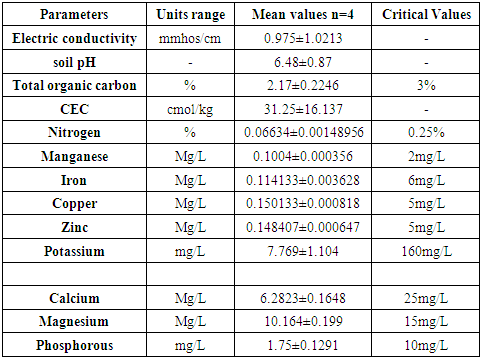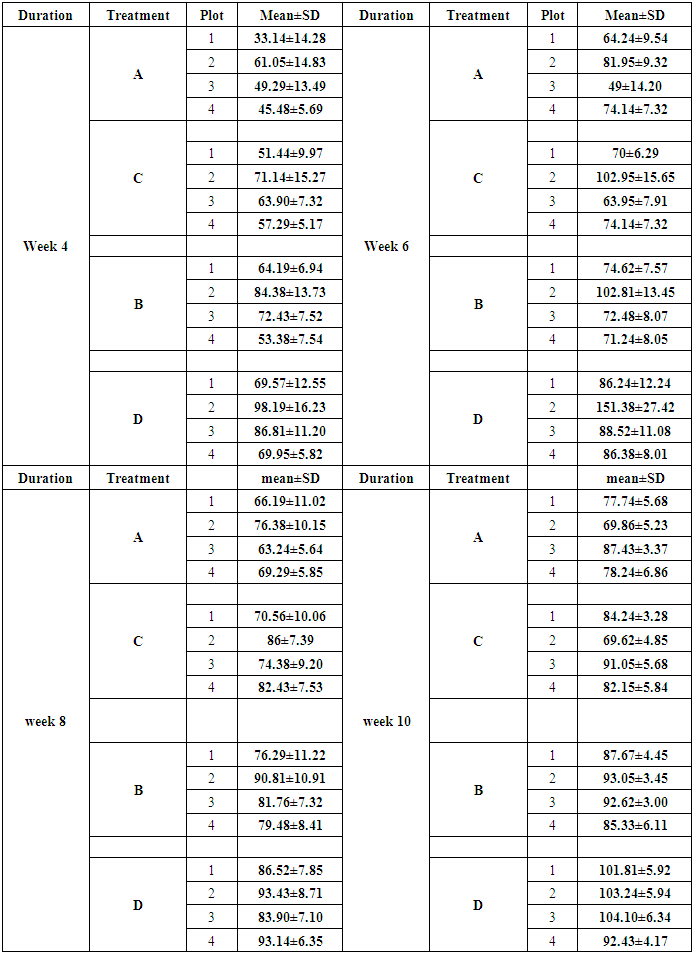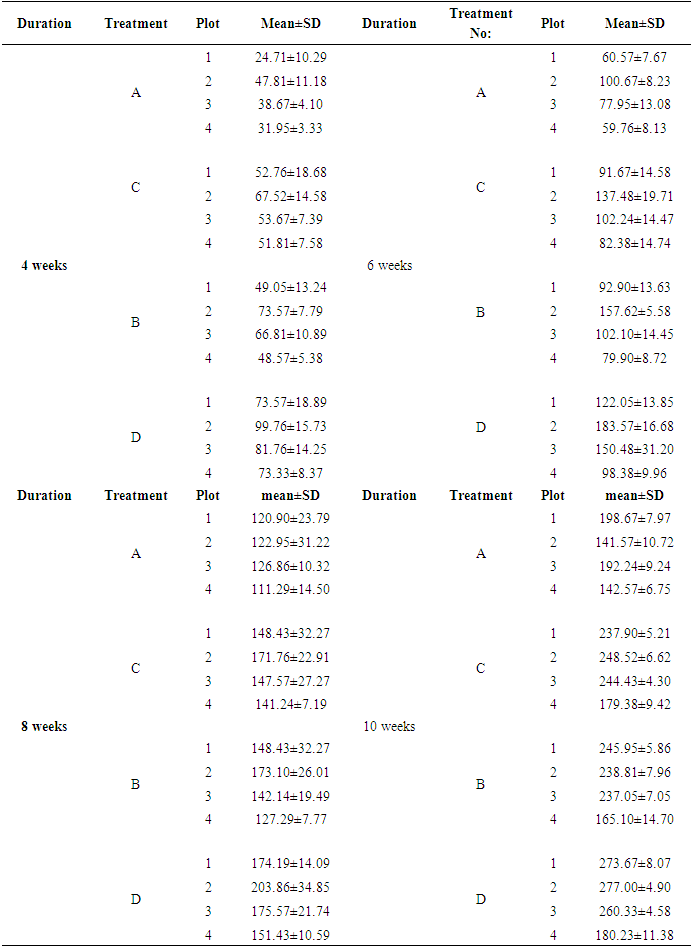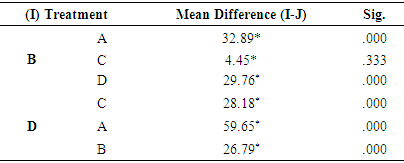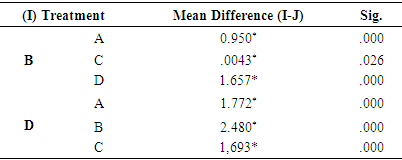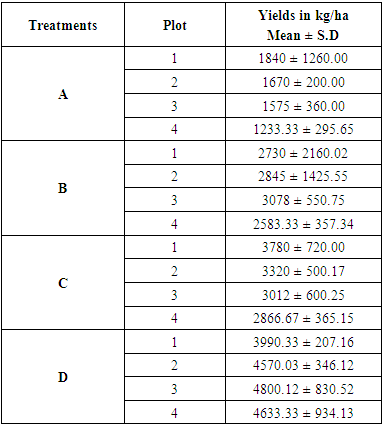-
Paper Information
- Paper Submission
-
Journal Information
- About This Journal
- Editorial Board
- Current Issue
- Archive
- Author Guidelines
- Contact Us
International Journal of Agriculture and Forestry
p-ISSN: 2165-882X e-ISSN: 2165-8846
2021; 11(3): 39-51
doi:10.5923/j.ijaf.20211103.01
Received: Sep. 1, 2021; Accepted: Sep. 29, 2021; Published: Nov. 15, 2021

Customized Potassium Foliar Feed for Optimum Yield of Maize in Nyeri County, Kenya
Wachira S. M., Mbuvi H. M., Masika E.
Chemistry Department, Kenyatta University, Kenya
Correspondence to: Mbuvi H. M., Chemistry Department, Kenyatta University, Kenya.
| Email: |  |
Copyright © 2021 The Author(s). Published by Scientific & Academic Publishing.
This work is licensed under the Creative Commons Attribution International License (CC BY).
http://creativecommons.org/licenses/by/4.0/

Majority of farmers in Nyeri County apply Nitrogenous and Phosphorous fertilizers to boost maize productivity. However, the acreage yield has remained low. Potassium (K) and micro nutrients fertilizers application in this region is limited. There is limited report on foliar feed application in this region. In the current study, nutrients levels in various farm soils of selected farms in Nyeri County were determined, customized potassium foliar feed was formulated to address their deficiencies. Grid sampling technique was used. Total nitrogen registered 0.0645- 0.067% below the recommended level of 0.25%, phosphorous recorded 1.6-1.9mg/L below the critical level of 10mg/L. The available Potassium had 7.769±1.104 mg/L; Calcium and Magnesium had 6.28±0.16mg/L and 10.164±0.199 mg/L respectively. This is below the critical values of 160 mg/L, 15mg/L and 25mg/L respectively. Zinc, copper, iron and manganese registered 0.1484±0.006mg/L, 0.1501±0.001mg/L, 0.1141±0.003mg/L and 0.1004±0.0003 mg/L respectively compared to critical values of 5mg/L, 5mg/L, 6mg/L and 2mg/L respectively. Customized K foliar contained Potassium, Phosphorous, Nitrogen, Magnesium and Calcium with 13.00±0.13mg/L, 6.64±1.02mg/L, 0.75±0.01%, 6.19±0.18 mg/L, and 23.90±1.10 mg/L respectively. In addition, zinc, copper, iron and manganese recorded 0.159±0.005mg/L, 0.668±0.008 mg/L, 0.34±0.18 mg/L and 0.46±0.003 mg/L respectively. Maize was grown in 12 plots of 5m by 5m with spacing of 50cm between the adjacent plots at each of the 4 selected farms. The 12 plots received same N and P basal fertilizer dosage of 70kg/ha. 3 plots received commercial foliar (20mg/L), 3 plots received half dosage (10mg/L) of customized K foliar, 3 plots received a full dosage (20mg/L) of customized K foliar while 3 plots received no foliar feed (control). Plant height, stem girth, ear length and grain yields were analyzed. Customized K foliar (20mg/L) increased plant height, ear length stem girth and maize yields. This study established that customized foliar feed significantly improved the maize yield in the region.
Keywords: Basal fertilizers, Soil nutrients, Maize yields, Foliar feed, Growth parameters, Yield parameters
Cite this paper: Wachira S. M., Mbuvi H. M., Masika E., Customized Potassium Foliar Feed for Optimum Yield of Maize in Nyeri County, Kenya, International Journal of Agriculture and Forestry, Vol. 11 No. 3, 2021, pp. 39-51. doi: 10.5923/j.ijaf.20211103.01.
Article Outline
1. Introduction
- Maize is a key cereal and a major staple food in Kenya with about 88% of households consuming it as a staple food (Olielo, 2013). It can be grown in a wide range of agro-ecological zone and climatic conditions (Bukhsh et al., 2012).Despite the fact that maize has wide ranges of environmental adaptability, its yield is still very low especially in Nyeri County (Ayaga et al., 2004). The acreage yields have constantly declined due to use of insufficient fertilizers which results to depletion of nutrients in the soil (Kiiya et al., 2006). One major problem affecting agriculture is low soil fertility (Kiiya et al., 2006). The nutrients distribution in the soil determines the soil fertility. Continuous use of land without proper replenishment of utilized nutrients has greatly resulted to decline in soil fertility (Wiebold and Scharf, 2006). The depletion of nutrients is caused by poor agricultural practices. These poor practices include: removal of crop residual for livestock, overgrazing and burning during the land preparation (Oborn et al., 2005). These poor agricultural practices have lead to drop in nutrients stocks where the annual depletion of nitrogen (112 kg ha-1), Phosphorous (31 Kg ha-1) and potassium (70Kg ha-1) nutrients (Ayaga et al., 2004). An adequate supply of nitrogen, phosphorous and potassium is essential for good growth and high yield of Maize. Nitrogen and phosphorous are very important nutrients for good vegetative growth and grain development. Potassium on the other hand is very crucial because it plays a very important role in physiological process in plants. Presence of potassium in crops affects more than 50 enzymes responsible for energy transfer, formation of sugar, starch and proteins (Taiz and Zeiger, 2006). It is the main requirement for maximum maize growth and yields (Saidou, et al., 2012). Potassium also helps plants to resist fungal and bacterial attacks by strengthening stalks of plants. In addition to this potassium also promotes the formation of good quality seeds as well as fruits. Calcium and magnesium are the other micro nutrients which are of good importance to the growth of maize. Magnesium in particular is very essential in very many biological systems (Bukhsh et al., 2012). A good example is adenosine triphosphate (ATP) which is the main source of energy in cell must be bound to a magnesium ion in order to be biologically active. This nutrient is very important in the synthesis of chlorophyll for photosynthesis. Calcium on the hand regulates the transport of other nutrients in to the plant, enforces the structural systems and plays a role in activation of certain plant enzymes. Deficiencies of calcium will results to stunted growth and rotting of plant (Romaniuk et al., 2018).Micro nutrients such as Boron, iron, copper, zinc and manganese cannot be ignored. They are equally important especially in plants development, they activates enzymes that are responsible for the synthesis of certain proteins as well as responsible for the formation of chlorophyll and conversion of carbohydrates, starches to sugar (Bukhsh et al., 2012). Deficiency of Boron in the soil may cause the weakening of pectin (Romaniuk et al., 2018). This is a fiber that is required by the plants to remain physically stable. It may also cause plants to stop growing. Food shortage in Kenya has been attributed to increased human population, shortage of land for cultivation and declining yields (Makhanu, et al., 2012). Use of phosphorus and nitrogen basal inorganic fertilizers and organic manure which is of low quality is the common practice by most small scale farmers across the country (Romaniuk et al., 2018).Foliar FeedFoliar is a liquid, water soluble fertilizer absorbed by crops through the leaves when sprayed. The leaves of plants are able to absorb essential nutrients directly (Fageria et al., 2009). Leaves stomata are used during the absorption of the essential nutrients. Plants are also able to absorb essential nutrients through their bark (Oborn et al., 2005). Potassium foliar can correct nutrients deficiency (potassium), increase resistance to pests and diseases, promote fruits growth and development, facilitates movement of water and other nutrients (Bukshsh et al., 2012) and reduces environmental pollution. Foliar feed has been used efficiently to supplement nutrient to crops (Kiiya et al., 2006). Foliar feeding nutrients are absorbed more effectively than soil-administered fertilizing. Foliar application has its advantages especially in avoiding the problem of leaching out in soils and facilitates quick reactions in plants. For nutrients required by plants in large quantities, soil application is more common. Application of foliar feed consisting of N, P and K has been found to have significant increase on the yields of soya beans (Wortmann et al., 2009). Foliar sprayed at the right time has been found to increase yields e.g. foliar sprays consisting urea and triple superphosphate increases the yields by 10-50% and 15-65% in trials on spinach, cabbage and pea (Fageria et al., 2009 ). Potassium foliar can be customized, that is, enriched with other important nutrients. This study aims at determining the available soil nutrients and formulating a customized foliar feed for optimum yield of maize.
2. Materials and Methods
- Farm site The experiment was carried out in Mathira constituency (0°25’ 12.47”N and 36°56’51.32”E) in Nyeri County, Kenya (0°24’ 59.99”N and 36°56’59.99”E).
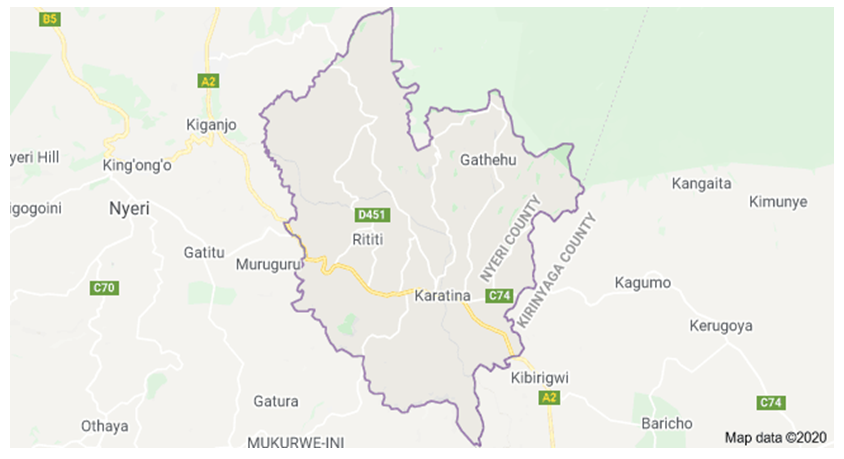 | Figure |
3. Results and Discussion
- Physicochemical parameters of farm soil samplesA summary of selected physicochemical properties and nutrient levels are provided in table 1. As indicated on the table, the soil samples had moderate range of total organic carbon of between 1.91-2.43% with a mean value of 2.17±0.2246 %. This range is within the moderate range of 1.5-3.0%. The farm soil samples were found to be deficient of phosphorus nutrient which ranged between 1.6-1.9 mg/L with a mean value of 1.75±0.1291 mg/L far below the recommended critical level of 10 mg/L. This deficiency can be attributed to the fact that there is low occurrence of phosphorous containing minerals in this region and due to long term farming (Wortmann et al., 2009). This study established that the soil sample had deficiency in the total Nitrogen levels which ranged between 0.064-0.067 percent with a mean value of 0.066±0.001%, values far below the recommended critical value (0.25%) (Bukhsh et.al. 2012). Although the soils were found to be deficient of nitrogen and phosphorus nutrients, it is important to note that majority of the farmers in this region mainly replenish them during planting.
|
|
|
|
|
|
|
|
|
|
 | Figure 1. Maize Yield Weight Bar Plot |
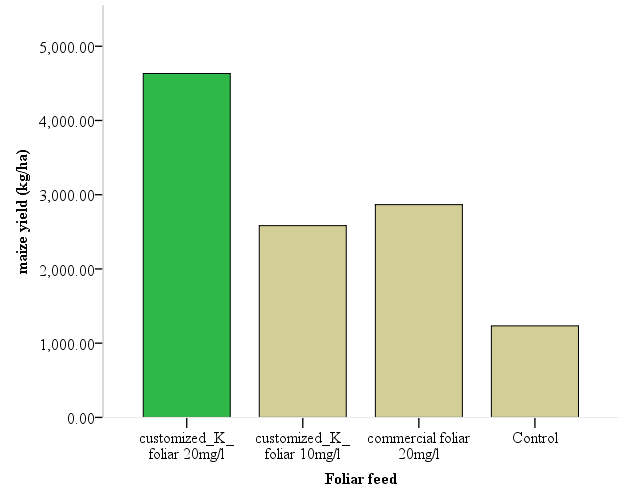 | Figure 2. Maize Yield Weight Bar Plot Based on Foliar Feed |
4. Conclusions
- This study aimed at determining the soil fertility indices such as the soil Organic Carbon, Cation exchange Capacity, Soil pH, available nitrogen, Potassium and available phosphorous and consequently to formulating Customized K foliar feed for farms in the selected farms in Nyeri County. The soil had a moderate range of total organic carbon with a mean of 2.17±0.2246%. Low levels of phosphorous (1.75±0.1291 mg/l), total nitrogen (0.21±0.0392%) and potassium (47.928±10.336 mg/L) were recorded from the soil samples. The soil recorded high pH values (6.48±0.87); moderate soil cation exchange capacity (12.5-50 Cmol/kg Cmol/kg) and moderate soil electrical conductivity (0.975±1.0213 mmhos/cm) Customized Potassium foliar feed was formulated to improve crop production in Nyeri country. The formulated Customized K foliar feed was neutral (pH value of 7.00 at 25.2°C), moderate levels of potassium ions (6.3421-6.9381 mg/L). Calcium (23.904-24.0382 mg/l), Phosphorous (1.2-1.4mg/l), Magnesium (3.445-3.555mg/L), and Nitrogen (0.8-0.9mg/L) levels were also moderate. Low levels of micronutrients such as Zinc (0.1583-0.1601mg/L), Iron (0.643-0.6683 mg/L), Manganese (0.46±0.003mg/L) and copper (0.34±0.18mg/L) were available in the formulated customized K foliar feed. As shown in the analysis section, maize plant ear length will increase if the nutrients are complemented. Results imply that application of treatment C in earlier stages improve leaf formation hence the ear length will be large in comparison to plants in the control sites. As shown in majority of maize plant height post hoc test, the significant mean difference is observed between plots that received treatment A and the other plots that received other treatment that is, treatment D, both B and C. This indicates that for long maize plant large quantities of potassium is required. Similarly, maize stem girth is shown to differ significantly with the applied foliar feed applied. Results shows that stem girth will increase from plots that received treatment A to the plots that received treatment D. On the analysis of the maize yield weight, it was observed that any difference in maize yields is as a result of supplement application. Results have shown a remarkable improvement of the foliar feed and result to even more weighted maize yield. Maize yields, stem girth, ear length and plant height increased significantly when the dosage of treatment B was increased from 10 mg/L to 20 mg/L. Treatment C increased the maize yields. However, the treatment could not increase the yields to much extent compared with treatment D. Plots that didn’t receive any foliar feed (Control) recorded the lowest maize yields. No mean difference was observed between treatment B and treatment C in terms of the maize yields.
5. Recommendations
- This study has shown that the soil nutrients in this region has depleted. Therefore there is need to supplement nutrients to the soil. Farmers and policy makers should put a lot of efforts to add more nutrients to the soil for optimum yield of maize. Customized K foliar feed can be used to correct nutrients deficiency especially soils with low levels of nutrients such as potassium, nitrogen, phosphorous and micronutrients. This study has shown that in this region, the soil is weakly acidic with a pH value of 6.48±0.87, continuous liming is required to improve the soil pH. Farmers and extension officers are therefore advised to first determine nutrients deficiency before choosing the kind of fertilizer to apply to the soil. Thus, the study recommends concentration of at least 20 mg/L of customized K foliar feed to be used for optimum yield of maize. This will result to healthier maize plant, strong and high maize yield. In conclusion, the application of customized foliar feed significantly improved plant growth (height, ear length and girth) and maize yields in Nyeri County.
 Abstract
Abstract Reference
Reference Full-Text PDF
Full-Text PDF Full-text HTML
Full-text HTML